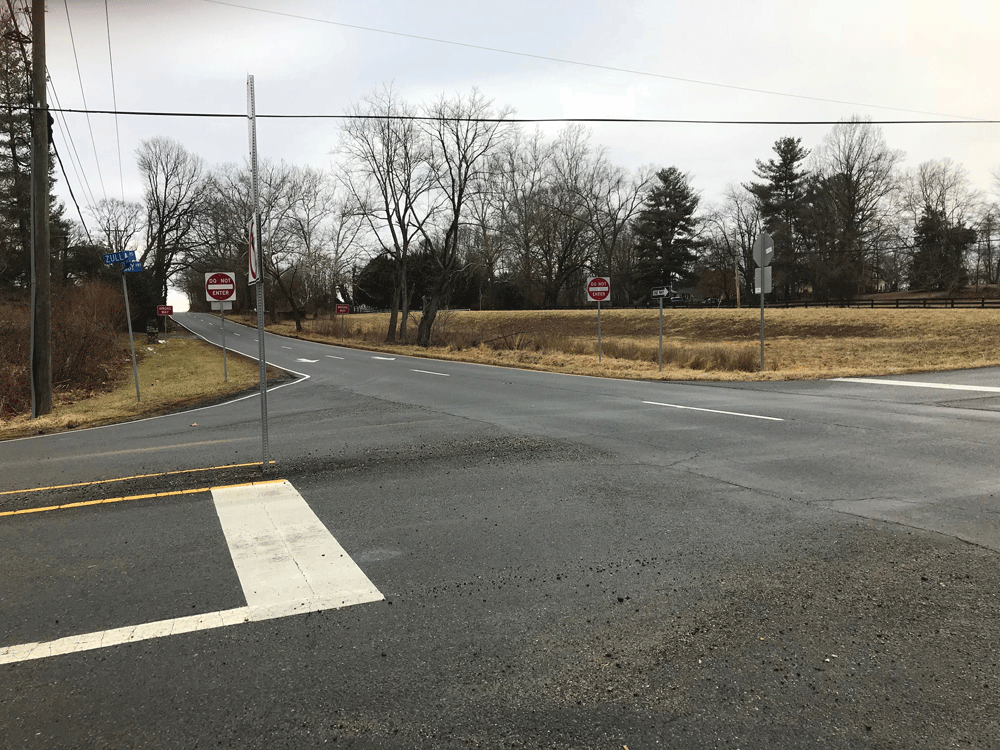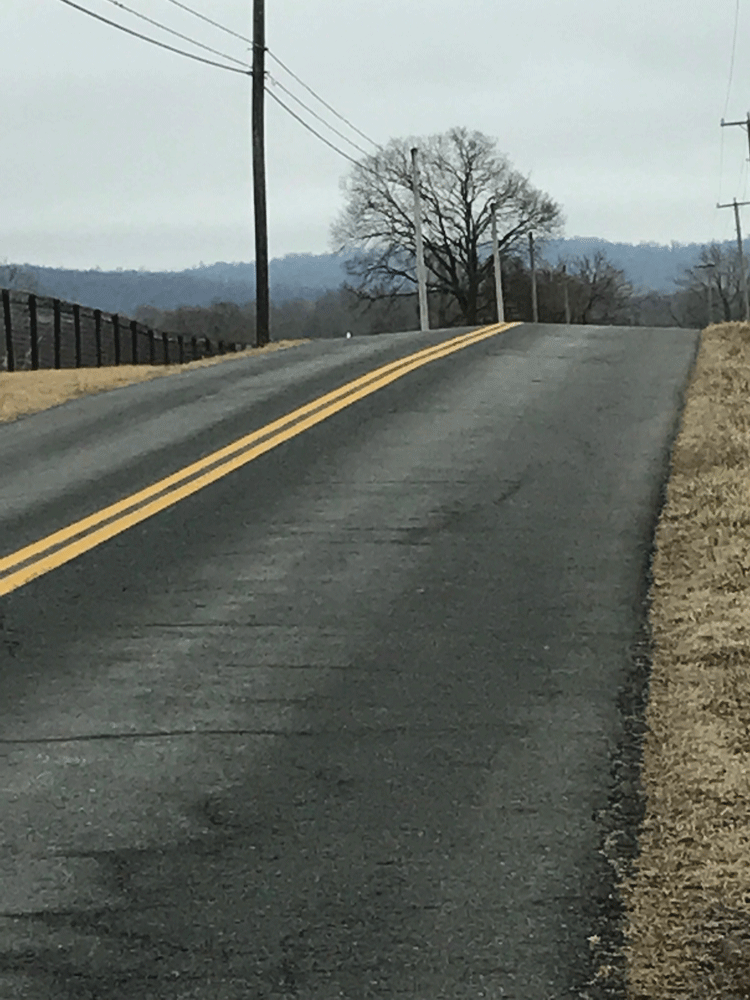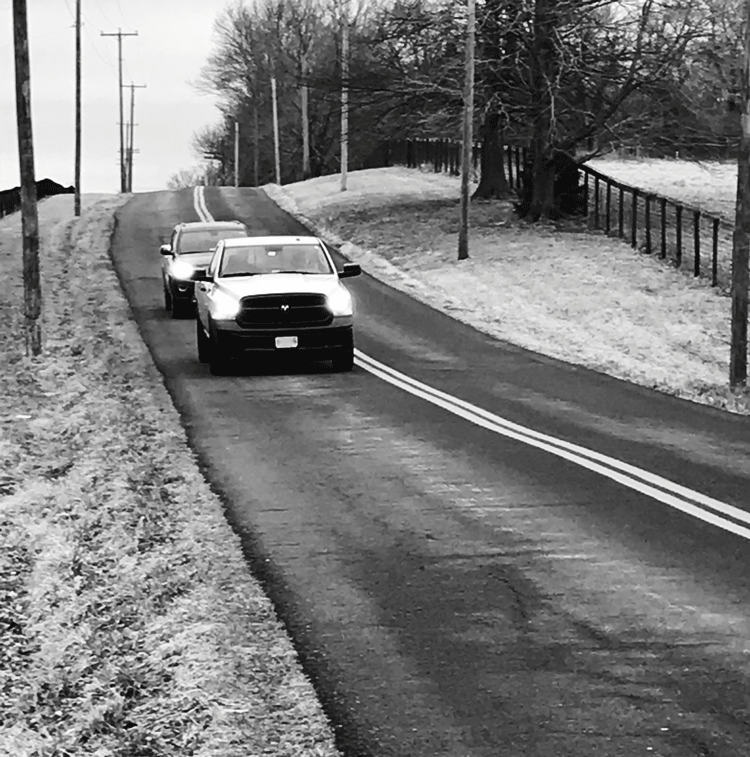Practice Patience Behind The Wheel

Story and photos by Beth Rasin
Tractors, texting and tourists are just a few of the hazards on rural roads. Here’s how to stay calm and drive safely on.
I’ll admit that I can be impatient. I’ve always got somewhere to go, a million things to get done, and better ways to spend my time than sitting in the car, no matter how inspiring a podcast may be. But having driven on either The Plains Road, Zulla, Atoka, 611, Foxcroft or others daily over the last 20 years, I’ve come to take a lot more caution behind the wheel than I once did.
And now, a fatal driving accident in January has spurred the Middleburg community to seek solutions to dangerous driving. So what can we each do to make the roads a little safer?

It starts, perhaps, with recognizing the risks.
Coming up The Plains Road toward Middleburg one morning a few years ago, I was behind a car that was following a tractor. There was no way to pass, but the car kept approaching the tractor and backing off. When the tractor, heading north, swung right to make enough room to turn left into a driveway, the driver immediately accelerated to pass him on the left. Unfortunately, he wasn’t pulling over to let her by; he was turning right into her car. In this case, no one was seriously injured (other than her vehicle), but it was a good example of how impatience behind the wheel is rarely constructive.
According to Nationwide Insurance, the National Safety Council estimates that 15,000 collisions involving farm vehicles occur on U.S. roadways each year. And although only 19 percent of Americans live in rural areas, 55 percent of highway deaths occur on roads that are considered rural.
It’s not just other drivers, either. I’m pretty sure the deer are on a mission to destroy themselves on the grill of my car, and I’ve taken to driving insanely slow at twilight, when they’re most likely to be on their suicide runs. (Department of Motor Vehicles statistics reveal that one in every 17 car collisions involves wildlife, and most of those occur at dawn or dusk.)

If you think you’re going to hit a deer, brake, don’t swerve. “Lift your foot off the brake rather than swerving, which could cause you to lose control of the vehicle,” says the Virginia Farm Bureau website.
And remember that deer travel in packs, so if you see one, stop or slow down and wait for the others to cross.
While they’re not as likely to be in the road as deer, cows have stopped me in my tracks more than once. And yes, so have horses. Every time you crest a rolling hill on these back roads, be prepared to stop in the event something is waiting on the other side of the slope. Safe driving is all about being able to stop in time, and on narrow, hilly roads, this is especially important, since you often can’t see as far ahead.
Tractors usually aren’t parked in the road, but they rarely travel more than 20 miles per hour, so the distance between a car going 60 miles an hour can pass very quickly. Often farm vehicles take up more than one lane, and it’s not advisable to pass them in a no-passing zone. Hopefully they have plenty of lights on—and will pull over to let you by at the first opportunity.

On the other hand, if YOU are the slow vehicle—think about pulling over and letting people pass, so you don’t create a conga line of annoyed drivers behind you.
Bicyclists: love them or hate them, they’re on our roads, and they’re vulnerable. It should go without saying that you shouldn’t drive too close to them!
“The bikers have an obligation to drive on the right side of road; they can’t occupy the whole road,” says Middleburg’s Chief of Police A.J. Panebianco. “They’re supposed to follow the same rules of the road that a vehicle has to follow. In turn, cars have to give them a three-foot break, so realize you’re sharing the road with them. When you have to wait to go up a hill to pass them, be patient—you’re taking five seconds longer to go up that hill—and be nice. Just because you’re in a hurry, don’t yell at them.”
Panebianco says whatever the challenge, the most obvious way to stay safe is to practice patience.
“The truth of the matter is that the overwhelming majority of time when I’m passed in my personal vehicle by someone in a super hurry, we get to a stop sign, and I’m beside or behind that person,” he says. “Where are they going to go that two to 10 seconds really makes a difference? My thing is, just take a breath, slow down and enjoy the view. We have some of the most beautiful roadways in Virginia, even the nation—the horse farms, wineries. People pay to fly here to see what we get to see every day for free, so slow down and enjoy it.”
And for the love of all things good, DO NOT turn left onto eastbound Route 50 at the end of Zulla Road—and beware of people from out of town who do so a few times per week.
“VDOT painted arrows in the roads [at the intersection of Zulla and Route 50] and put up a sign saying it’s a dual lane, but it’s not a huge, obvious sign,” says Panebianco. “People tend to be focused on their particular set of circumstances, and if they’re looking to go left… We hope to sign it better and take away the distractions.”
Panebianco, town councilmen Bridge Littleton and Kevin Daly and a few concerned citizens met with state senator Jill Vogel in February to work on traffic calming on Route 50 as well as the troublesome intersection with Zulla Road.

after I took this photo.
“A number of suggestions were made, from reducing the speed further back to rumble strips and an alert that it’s a dangerous intersection and more obvious signage that it’s split lanes,” Panebianco says. “When people are coming off Zulla Road, their GPS tells them to turn left, and that happens multiple times a week, so we’re trying to address how to avoid having that happen and have less potential for a crash by slowing down traffic.”
So don’t be in a hurry to get into town—or you’ll pay a price. “We’ve set up a speed sign to collect data, and we’ve increased enforcement efforts on Route 50,” says Panebianco. “If we stop you there, you are getting a ticket; we’re not giving breaks. We just had a fatality, and we don’t want to have another one. If all the signs and warnings and news of people getting killed doesn’t slow you down, the only option we have is to write tickets.”
He says the police often receive complaints of people passing on double lines as they’re approaching Middleburg. “That’s someone in a hurry, not slowing down but also driving very aggressively, and that’s going to cause an accident there too,” he says. “There are so many issues on Route 50—we’ve got to start somewhere, so we started with enforcement.”
Another thing Panebianco frequently sees is tired commuters. “They leave early and get back late, so they’re driving tired or distracted,” he says. “If you’re texting and not paying attention to the road, you’re going to do something that involves you in an accident. I’ve stopped people I’ve been convinced were drunk, pulled them over, and they’re just tired. They maybe left home at 3 a.m., and it’s 7 at night.”
He’s also trying to educate the community about safer driving. He gave a talk to students at Middleburg Academy about aggressive driving and distracted driving, and that PowerPoint presentation can be found on the Middleburg Police Facebook page.
Driving a car is one of the most dangerous things you do on a daily basis. We all need to get from Point A to Point B, but try to relax, enjoy the beautiful countryside, and keep your focus on what you’re doing—it’s only fair to yourself, your family and everyone on the road around you. ML


